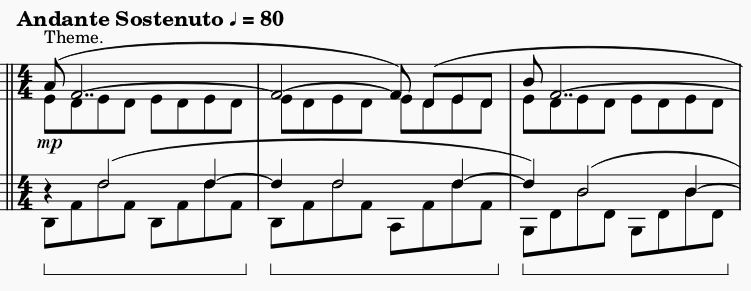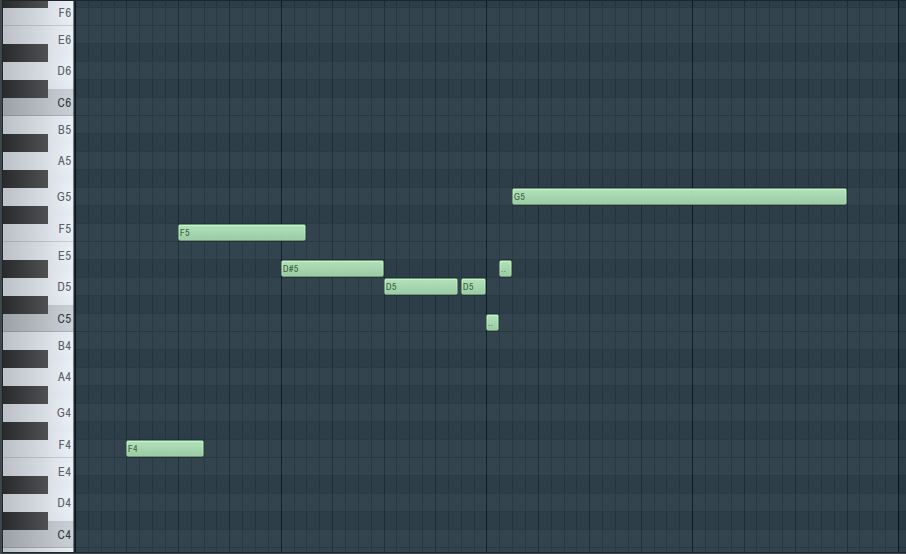Goal
The end goal for this lesson is to convince you to learn both sheet music notation and the piano roll. I also aim for you to have a clear understanding of what each notation style is and why it’s valuable to know both.
You have probably seen the piano roll and sheet music before, you may even be very familiar with one or the other. Many producers only ever learn the piano roll and many musicians only ever learn to read sheet music. Both are ways to write music down but they have different advantages. Learning each system will have large benefits to you. In fact there are 3 systems to write music that I want to introduce:
1. Sheet Music Notation

2. The Piano Roll

3. The Tracker
Each of these notation styles has many different programs out there that use one or multiple of these methods. For example, Cubase has both sheet music notation and a piano roll, however many programs that have more than one method of note entry also lack features. For example, in Logic the piano roll is much better than the sheet music editor.
The Piano Roll
The earliest form of the piano roll was player pianos.

These pianos would have a literal roll placed in them. The performer would then play the piano while the roll was spun, as the player played holes would get punched in the piano roll marking the spot that the key was pressed. At the end you had a literal roll that was a record of all the keys that were pressed and when they were pressed. Then by placing the roll back in the piano and spinning it at the same speed the piano would “read” the roll and play back the same notes at the same time effectively playing the piece back despite there no longer being a performer! Check out how they are made today.
This concept developed into the modern day piano roll found in most DAW’s today. It works on very much the same principle. There is a piano on the side of most piano rolls that shows what key will be pressed. Then when play is pressed a playhead will move along the piano roll and when it encounters a note it will play that note.

There are of course many new advantages with the piano rolls of today. They can have note velocity information, even dynamic information (how loud or soft to grow to) in a very specific form known as continuous controller data. They can trigger many instruments or just one and can be used to sequence just about anything to play whatever you want. There are tools to speed up note input, you can quickly chop notes up, generate complex patterns and easily copy and paste notes around.
However, this comes at a cost. The piano roll excels at specific instructions. It was not made with the intention of being easy to read or being a good way to think about harmony. Many piano rolls don’t support many basic ideas of music theory such as sharps and flats, or time signatures.
Many musicians who know how to read music find the thought of writing notes in with a piano roll to be absurd. It is so unreadable the thought of using it to write something seems unnecessarily complex. However, the piano roll is very easy to write in and excels at working with VST’s and other music technologies after you give it a go and learn your way around it. This fact is testified to by the countless producers who only ever learned the piano roll.
In many ways it is simple, but in the reading and writing of harmony it is soundly beaten by sheet music notation. The piano roll’s prevalence is due to the tremendous simplicity it affords when working in the Digital Audio Workstation.
Sheet Music Notation (Standard Notation)
Sheet music notation is old. Its entire existence comes from people trying to find a good system to write down what they hear. As a result it has developed into one of the best vehicles for talking about music. It’s used in nearly every genre, and is very adaptable. Because of its complex historical development there are some oddities that look strange to us today, much of which is due to the fact that it grew with the instruments that used it.
Today's music notation has been standardized and so sometimes you will see it referred to as standard notation. It works along a similar principle to the piano roll only this time special care was taken to treat it more like a language than just a set of instructions.

Horizontal lines are drawn that represent time. A speed is chosen that says how fast the piece goes. This is similar to the playhead moving in a DAW. The lines are broken into groups of time called measures.

Instruments that have no need of pitch information, such as the snare drum, can operate with just one line.

Instruments that have a need for pitch such as the piano use multiple lines. Higher lines and spaces represent higher pitches and lower lines and spaces are lower pitches. A system of symbols was created to represent if a note should sound or if it should be silent, referred to as a rest. By placing these symbols you can write rhythm.
Careful attention was done to this system that is not present in the piano roll. Many patterns emerge here that appear in a very easy to recognize way that are much harder to realize on the piano roll. For example, a 3rd in sheet music is when a note is a line or space above the root note (shown in the picture below). It has an easy to see shape. Something that is not clear in the piano roll. These examples will become more frequent the farther you go in music theory and is why sheet music is used instead of the piano roll for it.

Standard notation functions much more like a language, with a certain grammar and alphabet to work with. The ideas of harmony stack much more elegantly with music notation. It is an easy way to think of harmony, while the same things can happen on the piano roll there are more layers of complexity that make it unfavorable. For this reason sheet music is worth learning. This is why performers read sheet music and not midi. However sheet music lacks the precision of the piano roll. Often notes and styles must be interpreted where in the piano roll instructions are exact and there is no room for interpretation. Knowing both allows you to easily think and read harmony while also writing music into the computer that is exactly how you want it. Many sheet music editors now include a piano roll as well for this reason.
In fact sheet music is so much better at harmony than the piano roll it’s often completely left out of the discussion when learning harmony. So much so that it’s created a bizarre gap between many producers and musicians where both make music but neither has any concept of the other. I will strive to include it as much as possible because of how popular it has become.
The Tracker
I only mention the tracker here for fun. It is an old system, the first kind of DAW. Before user interfaces were figured out people would instead use trackers which were the first nice interfaces to write music with. It’s more like code than anything that looks like music at first glance.
Trackers can read a set number of instructions in a specific amount of time. Just like the tempo of music or the playhead of a piano roll. The way a tracker works is you write the note you want played at different instruction lines and that instruction is triggered at the moment the program gets to it. That’s it. Very simple but with it’s simplicity comes a complex system of writing and reading.
There is no thought towards harmony at all, no piano to guide you, no system to help you. You are left to your own mind to will melodies into existence with nothing but lines, letters and numbers. Because of this many unique abilities emerge however, effects are commands rather than the typical effects you may be used to. The resolution you can write with is very malleable and the way you write music is totally different.
I initially learned it because I wanted to know what the thinking was like, how the workflow “worked” and what advantages it offered. It can appear intimidating at first but there is indeed a workflow that is fast, efficient, inspiring and creative. I mention it here because it is probably the most versatile new take on music writing modern society has produced.
Advantages
Sheet Music Notation
Easy for a human to read Easy to read harmony, especially complex harmony Allows room for interpretation
The Piano Roll
Very exact and customizable Easy to record Integrates easily with software Intuitive
The Tracker
Most granular Interfaces with midi in a unique way Integrates easily with software FX writing is built in
Disadvantages
Sheet Music Notation
Many symbols Has a higher learning curve Not intuitive at first Writing it can be time consuming
The Piano Roll
Very hard to read harmony Can be a pain to write complex parts if you can’t play them in Can’t see multiple parts at once Structure of piece is harder to see
The Tracker
The most unintuitive to write with Steep Learning Curve In most cases requires knowledge of hexadecimal The most difficult to read
Conclusion
So now you understand what the 3 systems of notation are, their strengths and weaknesses, and why it's worth learning more than one. At times it may be frustrating when you're still learning the basics of a new system but stick with it! Could you imagine giving up learning your language before you could speak? Many choose to do this with music and it hurts your ability to express your ideas. Stick with it! It will be worth it!
-Composing Gloves
To support this series please consider donating via
paypalor joining the
patreon.